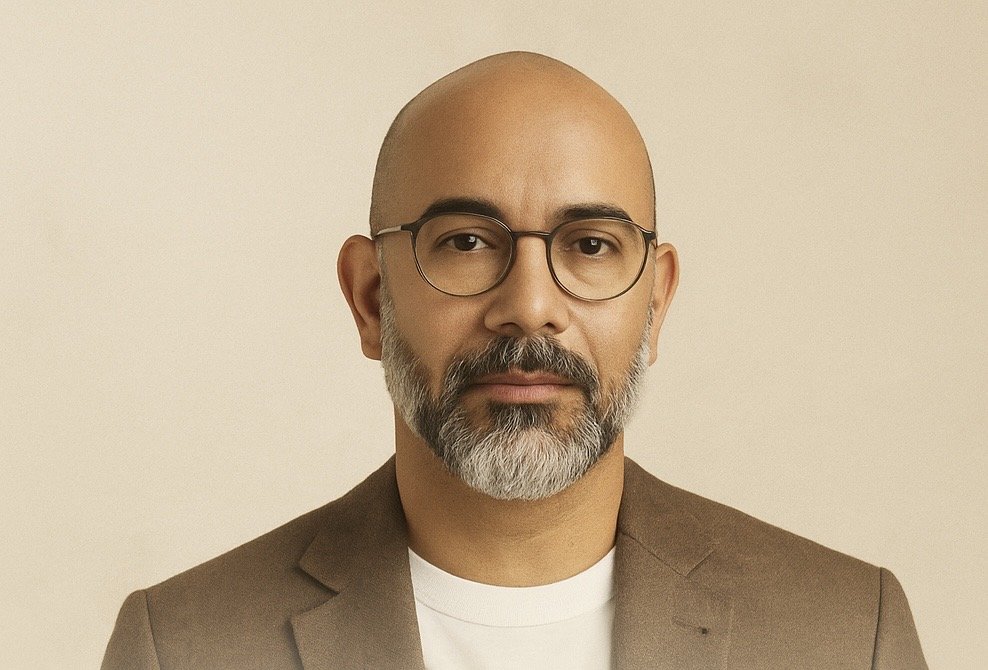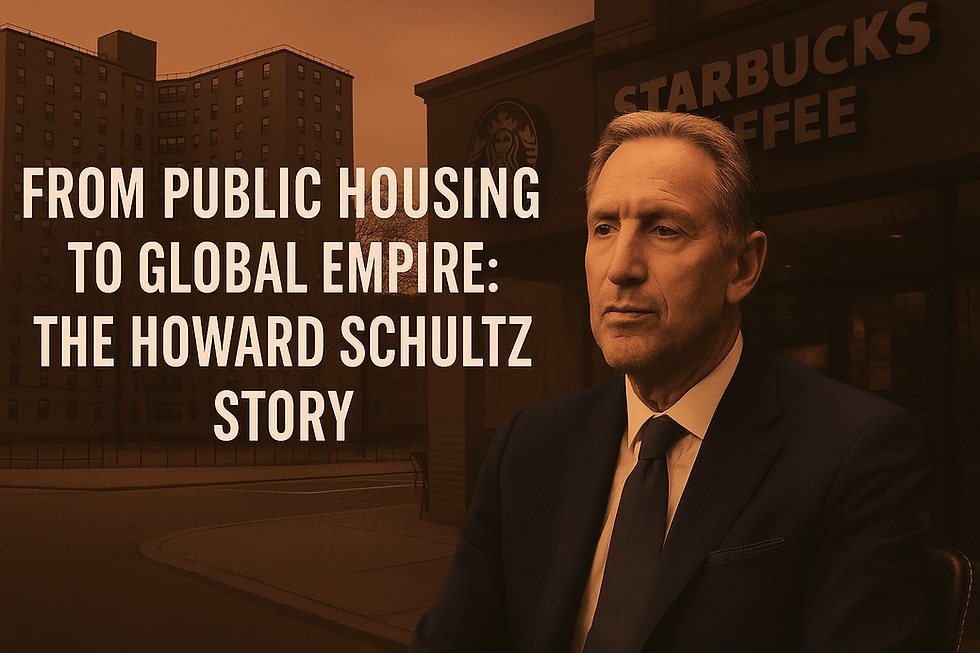From Public Housing to Global Empire: The Howard Schultz Story
- Dr. Wil Rodriguez

- Aug 1
- 5 min read
By Dr. Wil Rodriguez
TOCSIN Magazine

How One Man’s Vision Transformed Pain into Purpose and Built a $100 Billion Legacy
In the heart of Brooklyn’s Canarsie neighborhood, where hope often seemed as scarce as opportunity, a young boy watched his father struggle through yet another blue-collar job. Howard Schultz was born on July 19, 1953, to working-class parents Fred and Elaine Schultz, living first with his grandmother before moving to the Bayview Houses, a federally subsidized housing project. His father worked as a truck driver, his mother as a receptionist, and their combined income barely kept the family afloat.
But it was a single, devastating moment that would plant the seeds of what would become one of the world’s most iconic companies. When Howard was seven years old, his father broke his ankle while working as a truck driver. Since he had no worker’s compensation or health insurance, the family was left with no income and could barely afford the medical care he needed.
This wasn’t just a personal tragedy—it was a defining moment that would shape Schultz’s entire philosophy about business, dignity, and the treatment of workers.
The Awakening: When Coffee Became Calling
Howard grew up in public housing in Brooklyn and was the first in his family to graduate college. After graduating from Canarsie High School in 1971, he attended Northern Michigan University on what he hoped would be a football scholarship, though an injury forced him to quit the sport. He graduated in 1975 with a degree in communications, then began his professional journey as a salesman for Xerox Corporation.
But destiny had other plans. In 1981, Howard Schultz walked into the Pike Place store and was swept into a new world from his very first sip of Sumatra. That moment began the journey of a lifetime, taking them from whole-bean retailer to community coffeehouse. At that time, he reflected, “I had never had a good cup of coffee. I met the founders of the company, and really heard for the first time the story of great coffee… I just said, ‘God, this is something I’ve been looking for my whole professional life.’”
Vision Meets Resistance: The Italian Revelation
A year after meeting with Starbucks’ founders, in 1982, Howard Schultz was hired as director of retail operations and marketing for the growing coffee company. But Schultz’s transformative vision came during a business trip that would change everything. Inspired by a 1983 trip to Italy, where he discovered that Milan alone boasted 1,500 coffeehouses, Schultz envisioned turning a tiny regional operation into a national coffeehouse chain via rapid store expansion.
The founders, however, weren’t interested in his coffeehouse concept. They wanted to remain a bean retailer. So Schultz did what dreamers do when doors close: he built his own door. In 1985 he founded Il Giornale, a coffee concern that in 1987 (with investor backing) would eventually acquire Starbucks.
Building More Than a Business: A Culture of Compassion
What separated Schultz from other entrepreneurs wasn’t just his business acumen—it was his unwavering commitment to dignity. “My inspiration comes from seeing my father broken from the 30 terrible blue-collar jobs he had over his life, where an uneducated person just did not have a shot,” Howard reflected. These memories led Howard to provide access to health coverage, even for part-time employees.
This wasn’t just corporate policy—it was personal mission. As a young entrepreneur, he set out to build a different kind of company, one that delivers business excellence through a culture of compassion. While other companies saw employees as expenses, Schultz saw them as partners. While others focused solely on profits, he focused on people.
Under his leadership, Starbucks grew from eleven stores to over 30,000 locations worldwide, but the numbers only tell part of the story. He created a company that offered healthcare benefits to part-time workers, stock options to all employees (whom he called “partners”), and college tuition assistance—benefits that were revolutionary in the retail industry.
The Win-Win Philosophy: Success That Serves Others
It’s thanks to Howard Schultz that Americans today know what a latte is—and that they’re willing to drop $4 on one. But Schultz’s true genius wasn’t in creating coffee culture; it was in creating a business model where success multiplied success for everyone involved.
Every Starbucks store became a job creator. Every employee became a stakeholder through stock options. Every community gained a “third place”—neither home nor work—where people could connect. The company’s success created opportunities for farmers, suppliers, real estate developers, and countless other businesses in the ecosystem.
This is the essence of what you requested—a true “win-win situation” where one person’s rise from poverty creates pathways for thousands of others to build better lives.
The Resilience Factor: Owning Mistakes and Comeback Stories
Success didn’t come without setbacks. Two years ago Starbucks ran into trouble, and Schultz was called on to serve a second time as its CEO. He talks about the effects of the financial crisis on Starbucks’s sales, the surge of competition, and retaining authenticity despite growth. Schultz calls values, culture, and Starbucks’s reservoir of trust with its employees “the only assets we have as a company.”
When the company stumbled, Schultz didn’t make excuses—he owned the mistakes and led the turnaround. This resilience, learned from watching his father struggle through 30 different jobs, became the foundation of his leadership philosophy.
The Morality of the Story: Dreams Don’t Have Prerequisites
Howard Schultz’s story isn’t just about coffee—it’s about the fundamental truth that greatness doesn’t require a trust fund, an Ivy League education, or family connections. Schultz came from humble beginnings, growing up in public housing in Brooklyn. He had no inheritance, no family business to inherit, no safety net.
What he had was vision, persistence, and an unwavering belief that business could be a force for good. He proved that you can build an empire while building others up. He demonstrated that success is sweetest when it’s shared, and that the most sustainable businesses are those that create value for all stakeholders—employees, customers, communities, and shareholders alike.
The Invitation to Dream Bigger
For those who doubt their dreams, who question whether someone from their background can achieve greatness, Howard Schultz’s story stands as powerful proof that excellence has no zip code. Whether you’re in public housing in Brooklyn or anywhere else in the world, whether you’re the first in your family to graduate college or didn’t graduate at all, whether you have capital or just courage—you have what it takes to build something extraordinary.
The question isn’t whether you have the right background. The question is whether you have the right vision and the willingness to persist when others say no.
Schultz didn’t just build Starbucks; he built a template for how business can be done differently. He showed that treating people with dignity isn’t just the right thing to do—it’s the profitable thing to do. He proved that companies can grow exponentially while growing consciously.
Reflection Box
As we reflect on Howard Schultz’s extraordinary journey from the housing projects of Brooklyn to building a global empire worth over $100 billion, we’re reminded that our circumstances don’t define our potential—our choices do. Schultz’s story teaches us that true success isn’t measured only in dollars but in the number of lives we lift along the way. Every challenge he faced—from his father’s injury to investor rejections to business setbacks—became fuel for a larger vision. His legacy isn’t just the green siren on every street corner; it’s the proof that when we dream boldly and act compassionately, we can transform not just our own lives but entire industries and communities. The boy who once worried about his family’s next meal grew up to ensure that hundreds of thousands of Starbucks partners worldwide have healthcare, education opportunities, and a pathway to prosperity. That’s not just a business success story—that’s a human triumph story.
- Dr. Wil Rodriguez, TOCSIN Magazine
Ready to discover more inspiring stories of triumph and transformation? Explore the full collection of success stories and business insights at TOCSIN Magazine. Join our community of dreamers, doers, and game-changers by becoming a member at tocsinmag.com and never miss an issue that could change your perspective on what’s possible.








Comments